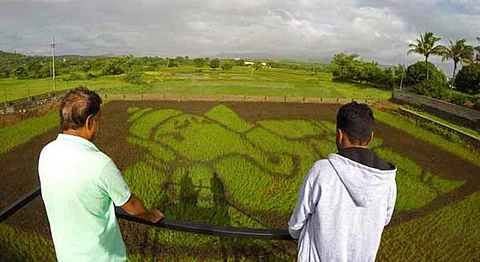
- HOMEGROWN WORLD
- #HGCREATORS
- #HGEXPLORE
- #HGVOICES
- #HGSHOP
- CAREERS
- ABOUT US
- CONTACT US

When the farmers of Inakatade village in Japan wanted to beautify their idyllic setting back in 1993, they started a new form of landscape design that went beyond the conventional practices of using exotic flowers and plants. By growing rice crops that had leaves of different colours, they created a huge replica of the iconic Mount Iwaki, on one of the farms. That is when Tambo Ato, or Rice Paddy Art, came into existence. After 23 years, an engineer and a botany enthusiast from Maharashtra ventured into bringing this unique art to India. A native of Pune, Shrikant Ingalhalikar has created a stunning 40-meter-long Ganesha design on a paddy canvas, in a village called Donje Phata nestled amid the rolling Sahyadri mountains.
Shrikant, now 64, nurtured his passion for nature by studying about it, writing articles and books, and also by pursuing wildlife photography. After starting a blog called Flowers of Sahyadri, he has authored three books that catalogue the different flowers thriving in the world biodiversity hotspot of Sahyadri.
Being an accomplished arborist, Shrikant was astonished by the rice paddy art of Inakatade when he first came across it a few years back on the Internet. “I was into rice cultivation for the past 25 years, and the fact that some farmers in Japan are creating art on paddy fields was extremely interesting. I could not implement it right away because I was aware of only the green-coloured leaves of the rice plant. Whereas in Japan, they have five colours. It is restricted to import these seeds to India,” he told us. It was then that Shrikant decided to research about the local types of rice seeds, and came across a variety having purple coloured leaves that could be used with the green.
Soon, what followed was the challenging process of reaping rice plants and placing them in a field of knee-deep slush to create the paddy art. “We transferred the hand-sketched design to a computer and enlarged it in proportion to the field’s dimensions. After drawing gridlines on the paper, we replicated them on the field and planted the saplings accordingly. The entire process from sowing to re-planting lasted from June to September,” Shrikant explained. Only one from his many farms, that was located on a relatively lower height than the others, was chosen as the canvas allowing the art to be viewed from an elevated platform.
In an agrarian country like India where rice is one of the most abundant crops, rice paddy art aims to mark its significance not only in tourism but also in reviving the traditional practices of farming. “With this project, I urge the locals to take up farming instead of selling their lands, and conserve the precious skill-of-hand that is on the verge of extinction now that farming can be done with machines,” Shrikant concluded.
If you wish to know more or visit the rice paddy art, you can contact Shrikant Ingalhalikar here.
If you enjoyed reading this, we suggest you read:
Feature image via NRInews24x7
